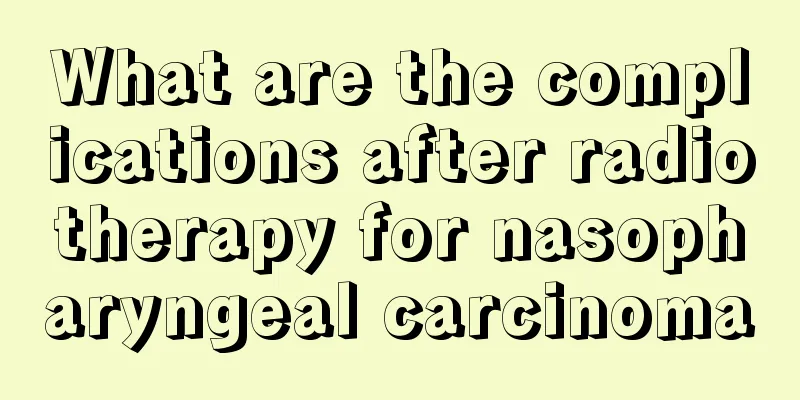What are the complications after radiotherapy for nasopharyngeal carcinoma

|
Nasopharyngeal carcinoma is mostly poorly differentiated adenocarcinoma and is sensitive to radiation. Therefore, the current treatment of nasopharyngeal carcinoma is mainly radiotherapy. However, the complications after radiotherapy of nasopharyngeal carcinoma cannot be ignored by patients and their families. If the complications after radiotherapy of nasopharyngeal carcinoma are not treated and resolved in time, it will definitely affect the patient's treatment effect, and in severe cases it will cause other complications that endanger the patient's life. 1. Common complications after radiotherapy for nasopharyngeal carcinoma 1. Systemic adverse reactions: Due to the intake of radiation, the human body will have systemic abnormal reactions, such as fatigue, dizziness, poor appetite, nausea, vomiting, insomnia or drowsiness. For most patients, the blood picture or liver and kidney function will not be significantly affected. For some sensitive people, it will also cause a decrease in white blood cells and platelets. For patients with poor liver function or positive hepatitis A antigen (HAA) or cirrhosis, it will cause liver damage and special attention should be paid. 2. Acute radiation reaction of parotid gland: Within the first 1-2 days after the start of radiation, the patient will complain of swelling and pain in the parotid area on the irradiated side. This is due to acute congestion of the parotid tissue caused by radiation. The swelling generally does not require treatment and will subside on its own after 3-4 irradiations. 3. Skin radiation reaction: The skin in the irradiation field of nasopharyngeal carcinoma will cause a series of skin reactions after being exposed to radiation. The initial symptoms are skin erythema and pigmentation, followed by hair loss, dry peeling, and in a few patients, blisters will form, which will fuse into large areas of moist dermatitis and superficial ulcers. The severity of the skin reaction is related to the quality and dose of the radiation. High-energy radiation can relatively reduce skin reactions, but individual differences are also very important factors. Different patients may have completely different skin reactions under the same conditions and the same dose. 4. Mucosal reaction: Mucosal reaction refers to the increased congestion, edema, and exudation of the oral, oropharyngeal, nasopharyngeal, nasal, and paranasal sinus mucosa after a certain period of irradiation. In severe cases, punctate or flaky white film may appear, with symptoms such as pain, difficulty eating, nasal congestion, and increased viscous secretions. Almost every patient has these mucosal reactions, but the severity varies. 5. Wet reaction in the external auditory canal or otitis media: When the external auditory canal is exposed to radiation doses of about 50 GY, the ear canal mucosa may react wetly or the middle ear may accumulate fluid or the ear canal membrane may be pierced to form pus. Early prevention should be adopted, such as the use of antibacterial ear drops, and early administration of needle drops when there is fluid accumulation in the ear canal to prevent excessive accumulation of fluid from causing tympanic membrane rupture. When there is repeated middle ear effusion, a plastic tube can be placed for drainage. 6. Radioactive facial and neck edema: This is due to poor lymphatic drainage of the face and neck tissues after irradiation, edema and occlusion of deep capillaries, and obstruction of microcirculation, which causes facial and submandibular edema. Generally, no special treatment is required for edema of the neck, which can disappear on its own 4-6 months after radiation. If the edema is severe and induces infection, and causes acute cellulitis, it should be actively treated, preferably with high-dose intravenous antibiotics. In severe cases, anti-edema drugs, hormone mouth and leg cleansers, and symptomatic treatment should be given at the same time. |
<<: Is laryngeal cancer contagious?
>>: What is the 5-year survival rate for stage 3 nasopharyngeal carcinoma?
Recommend
What are the benefits of drinking lotus leaf soaked in water
Lotus root leaves refer to lotus leaves. Everyone...
How to care for liver cancer patients in hot summer? Liver cancer patients should know these 4 rehabilitation knowledge
Liver cancer has a high incidence and mortality r...
What is acute meningitis?
Since acute meningitis is a sudden disease, the m...
Abscess in groin
Folliculitis is a type of pus-filled swelling on ...
Why is there blood in the sputum after eating seafood?
Seafood is a food that people love to eat in dail...
How much does it cost to treat liver cancer
Regardless of the cost, patients with liver cance...
What to do if you feel uncomfortable wearing dentures
Everyone hopes to have a healthy body, but once t...
What are the dietary taboos for gastric cancer
As the times progress, people's living standa...
Is vaginal bleeding a symptom of cervical cancer? What is the best food to prevent cervical cancer?
Cervical disease has become the main killer of wo...
The relationship between high uric acid and renal function
High uric acid level is a metabolic disease cause...
Are there any other uses for expired sanitary napkins?
Women are different from men. Women experience ph...
What organ is the appendix
The appendix is a type of tissue located in the...
What affects the body's metabolic rate?
Everyone is undergoing metabolism every day, and ...
Symptoms of nail melanoma
Our bodies are often troubled by some inexplicabl...
What is the pupil's light reflex?
Eyes are the windows to the mind, and their impor...









